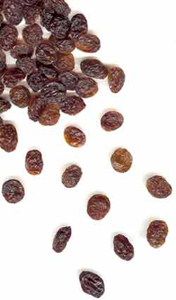 Filling the Featured Guest Blogger of the Month for March is Julie Miller Jones, Ph.D., L.N., CNS, a professor emeritus of The College of St. Catherine in St. Paul, Minnesota. She also serves as the national nutrition advisor for the California Raisin Marketing Board.
Filling the Featured Guest Blogger of the Month for March is Julie Miller Jones, Ph.D., L.N., CNS, a professor emeritus of The College of St. Catherine in St. Paul, Minnesota. She also serves as the national nutrition advisor for the California Raisin Marketing Board.
On the heels of national Heart Health Month, there’s good news for older Americans. A new University of Connecticut study, published in the journal Metabolism: Clinical and Experimental, finds eating raisins and walking may reduce the risk of cardiovascular disease for both women and men in the 50 to 70 year-old age range. Raisins are not only fat and cholesterol-free, they also contribute heart-healthy components, such as fiber, potassium, and antioxidants.

A one ounce serving of heart healthy raisins has 85 calories, 0mg Cholesterol, 3mg Sodium, 1.1g Fiber and .9g Protein.
According to the study, walking and daily consumption of raisins (1 cup) decreased low density lipoprotein (LDL) cholesterol, aka “bad cholesterol,” levels in the blood stream. These new findings add to previously published data that determined in addition to lowering “bad cholesterol,” raisin consumption and walking reduced markers of inflammation associated with cardiovascular disease.
The health benefits of raisins aren’t just limited to this age set. Both the American Heart Association and the Food and Drug Administration (FDA) emphasize the role of fruit and vegetable consumption in supporting heart health for all ages. The Produce for Better Health Foundation notes that 90 percent of Americans fail to consume the daily recommended servings of fruits and vegetables.
Another recent study, by researchers from the Loyola University Health System in Chicago, suggests consuming twice as much potassium as sodium can halve your risk of dying from cardiovascular disease. So if you want to eat a diet that helps maintain a healthy blood pressure, reduce cardiovascular risks and counters the effects diets high in sodium, limit high salt foods and choose the DASH diet, which includes many vegetables and fruits that will increase potassium intake.
The game plan is easy. Fill your cart with minimally processed fruits and vegetables, prepare them in delicious ways without much added salt. This strategy helps to minimize the consumption of sodium and pumps up the potassium. A few tasty options that can help increase the potassium in your diet include, bananas (one medium-sized has 422 mg), potatoes (one medium-sized with the skin-on has 620 mg), spinach (½ cup, cooked has 950 mg) and California raisins (1/4 cup has 310mg).
For more information and healthy recipes including California raisins, visit www.loveyourraisins.com.
Guest Blog Series: Look for the following badge on your favorite health sites to see if they have been a featured guest blogger on DietsInReview.com. See other posts in the Guest Blog series.
If you would like to apply to be featured as a guest blogger, please contact us.

